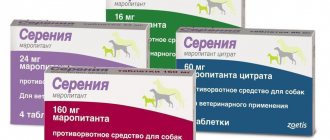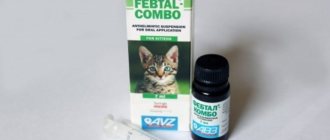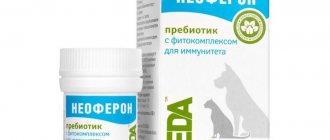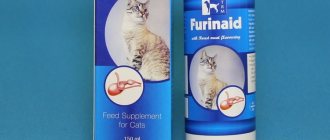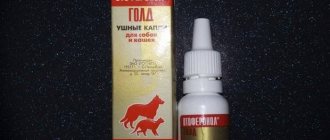Cats are one of the hardiest pets and rarely get sick.
But if your pet has health problems associated with infection of the body with various types of bacteria and viruses, antimycoplasma drugs should be used. One such medicine is Baytril. For cats, this remedy is used quite often. In this article you will read instructions for use, contraindications for use, cost, etc.
Baytril is a broad-spectrum antibiotic that is very actively used in veterinary medicine. Manufactured in Germany by Bayer.
Properties and principle of operation
Baytril has a broad antibacterial effect. It is also capable of destroying fungi. The drug is effective against the following types of bacteria:
- proteas;
- streptococci;
- salmonella;
- staphylococci;
- clostridia, etc.
The medicine is successfully used to destroy hemophilus influenzae infection, as well as microorganisms that can cause diseases of the digestive, genitourinary and respiratory tract.
The principle of action of the antibacterial agent is that enrofloxacin blocks the production of an enzyme in harmful microorganisms that are responsible for the formation of DNA. DNA damage prevents bacteria from multiplying and contributes to their rapid death.
At the injection site, the drug is quickly absorbed and, together with the blood, enters almost all organs and tissues. The antibiotic has a rapid action - in just half an hour its concentration in the blood reaches its maximum value. Throughout the day, the drug retains its effect. It is excreted from the body mostly unchanged along with urine and bile.
The antibacterial agent is a moderately dangerous drug, since it does not have hepatotoxic or embryotoxic effects and does not have the ability to accumulate in the body.
Properties, principle of action and indications for use
Baytril for cats
A broad-spectrum antibacterial drug (antibiotic), which is also effective against a number of fungi, is prescribed when the following pathogens are identified in a cat:
- streptococci;
- staphylococci;
- salmonella;
- proteas;
- clostridia;
- Haemophilus influenzae.
The drug is quickly distributed throughout the tissues, providing a therapeutic effect within 20-30 minutes after administration of the drug.
Baytril is active for a day from the moment it enters the body, after which it is excreted in urine and feces. It has been proven that in the tissues of the affected organ the concentration of the drug is significantly higher than in healthy ones.
For cats, an injection solution with a concentration of 2.5% is used.
The main indications for using an antibiotic are:
- diseases leading to inflammation of the respiratory system;
- salmonellosis;
- bacterial lesions of the intestines and stomach;
- inflammatory pathologies of the genitourinary system;
- colibacillosis;
- purulent wounds;
- infections caused by microorganisms sensitive to antibiotics;
- abscesses;
- inflammatory skin lesions.
The drug is prescribed independently or in complex therapy at the discretion of the veterinarian. It is strictly prohibited to use medicine to treat a cat without a prescription, as well as to unauthorizedly change the duration of the course and dosage of the medicine.
Instructions for use of Baytril for birds
Baytril 10% is recommended for the treatment and prevention of dangerous diseases in birds.
If the rules of use and storage are followed, the medication is well tolerated by birds without causing side effects. Before use, you should read the instructions.
For poultry
For the prevention and treatment of diseases in poultry (ducks, geese, turkeys and other livestock), Baytril 10% is used for oral administration. To use the medicine, for example, for chickens, you need to dilute 5 ml of the medicine in 10 liters of drinking water and pour it into drinking bowls. In order to save medicine, you should calculate in advance what the daily water consumption of birds is.
The duration of treatment for severe infectious diseases is from 5 days, for mild ones - from three days. In rare cases, the course of treatment may be extended by the veterinarian after examining the birds. It is necessary to prepare a fresh solution daily to avoid the development of side effects and complications.
For quails
For small quails, the use of Baytril is recommended in hot weather, when the birds' bodies are weakened and exposed to bacterial attacks. To prevent and treat diseases, quails are given 1 ml of Baytril 10% per liter of drinking water. The course of administration depends on the condition of the bird and the type of infection, but should last no less than 5 and no more than 12 days. During this period, ordinary water cannot be given, only a medicinal solution.
For pigeons
Baytril dosage for pigeons is 1 ml/1 liter of water. Sometimes birds may refuse to drink the offered solution. In this case, the farmer will have to solder each individual separately, using a syringe without a needle or a pipette. Baytril for pigeon chicks is used as follows:
- At the age of 10–20 days, the dose is 1/20 of a 1 ml ampoule.
- For chicks 21–40 days old - 1/10.
- At the age of 41–70 days - 1/5 part.
The course of treatment lasts 3–5 days depending on the condition of the birds and the purpose of use. Before using the medication, it is recommended not to feed the pigeons for a day.
For parrots
Baytril 10% for oral administration is also used to eliminate symptoms and improve the condition of parrots. The product is diluted in water at the rate of 1 ml/0.2 l and given to parrots for 5 days.
CONFIRMATION OF THE EFFECTIVENESS OF BAYTRIL IN SMALL ANIMALS
Dogs: Clinical effectiveness has been established in skin infections (wounds and abscesses) associated with susceptible strains of Escherichia coli, Klebsiella pneumoniae, Proteus mirabilis and Staphylococcus intermedia; respiratory infections (pneumonia, tonsillitis, rhinitis) associated with susceptible strains of Escherichia coli and Staphylococcus aureus; and urinary cystitis associated with susceptible strains of Escherichia coli, Proteus mirabilis, and Staphylococcus aureus.
Palatability: free choice flavors Baytril Taste Tabs
were confirmed in a study in which 350 individual dosages resulted in voluntary consumption of 73%.
Cats: Clinical effectiveness has been established for skin infections (wounds and abscesses) associated with susceptible strains of Pasteurella multocida, Staphylococcus aureus and Staphylococcus epidermidis.
Method of application: dosage, frequency, duration of treatment
The medicine is administered subcutaneously to sick animals. The course of therapy lasts from 3 to 5 days. Typically, injections are given within 5 days to completely destroy pathogenic bacteria. In some cases, the course can be extended to 10 days. This is necessary if the pathology is mixed, difficult to treat, or has reached a severe stage. If there is no positive dynamics in the first 3–4 days, the question of replacing the drug is raised. In this case, tests are carried out to determine the susceptibility of the pathogen to the active substance.
The injection is given once a day, since the therapeutic effect after the injection lasts for 24 hours. If the daily dose is too large, then it can be divided into 2-3 parts. In this case, the medicine is administered 2-3 times a day at regular intervals.
The dosage is calculated individually for each patient. Baytril is prescribed to cats in a minimum concentration of 2.5%. According to the instructions, 0.2 ml of solution is administered per 1 kilogram of weight.
You cannot change the dosage, number of daily injections or course duration on your own. Any changes to the treatment regimen should only be made by a veterinarian. If you miss the next injection, you need to give it as soon as possible, and then re-administer the drug according to the schedule established by the doctor.
Baytril does not have a selective effect, therefore, along with pathogenic microorganisms, it also kills the internal microflora of the cat’s intestines. Given this circumstance, veterinarians often prescribe supplements containing beneficial bacteria to cats to restore intestinal function.
- individual hypersensitivity to enrofloxacin and substances included in the drug;
- pathologies of the nervous system with convulsive syndrome;
- abnormalities in the development of cartilage tissue;
- the period of bearing and feeding offspring;
- age of kittens and puppies under 12 months;
- defeat by pathogenic organisms that are immune to the active component.
Although the instructions for Baytril do not directly indicate the treatment of animals under the age of 1 year, veterinarians do not prescribe it during this period. This decision is explained by the influence of enrofloxacin on the process of cartilage formation. In growing kittens, the drug can cause disturbances in the development of bones and internal organs.
When treating pregnant and lactating females, medications are used with extreme caution. Since antibiotics penetrate the placental barrier, they can disrupt the normal development of embryos, cause intrauterine mutations, pathologies of organ formation and fetal death.
The highest risk of complications after taking antibiotics occurs in the first half of pregnancy. If there is a possibility that the female is carrying cubs, you should inform your veterinarian. The specialist must choose a safer remedy for treating the expectant mother.
If you follow the recommendations specified in the instructions, the use of Baytril does not cause adverse reactions. Some animals may experience nausea, occasional vomiting, weakness, upset stool, and refusal to eat. These symptoms do not pose a threat to the life of pets and disappear after cessation of therapy.
Contraindications
Despite the fact that the drug is low-toxic and effective against many pathogens, Baytril has some contraindications. Thus, the medicine is not suitable for pregnant cats and those nursing offspring, kittens under the age of six months (large breeds like Maine Coons - up to a year), as well as animals prone to seizures, epilepsy, diseases of cartilage tissue, and allergies to fluoroquinolone.
It is prohibited to take Baytril simultaneously with non-steroidal anti-inflammatory drugs, chloramphenicol, tetracyclines, macrolides and theophyllines.
Side effects
If the dosage is followed and treated under the supervision of a veterinarian, the side effects of Baytril are reduced to zero. As we mentioned above, the main inconvenience is pain for the cat both during and after the injection.
Self-administration of Baytril by the owner to his pet is strictly prohibited!
In order to reduce pain, Baytril injections are given to different areas on the animal’s body. However, there is a possibility of other side effects. These include allergic reactions - if a negative effect is detected, the medicine is immediately discontinued. Problems may also arise if the injection solution accidentally enters the animal's stomach.
In this situation, dyspeptic disorders (diarrhea, vomiting), swelling of internal organs and tissues, shock, problems with the kidneys and liver are possible. If the owner suspects that the drug was consumed orally by the animal, he should immediately contact a veterinary clinic.
Antibiotic therapy is prescribed only after a complete examination of the animal and diagnostics.
Contraindications and possible side effects
There are strict contraindications for the use of the drug in the treatment of cats. Their compliance is mandatory.
It is unacceptable to use the composition in the following cases:
- pathologies of the nervous system of varying severity;
- convulsive conditions;
- individual intolerance to the drug;
- pathology of cartilage tissue;
- bearing kittens;
- feeding kittens.
Also, the medicine is not used if the bacteria that caused the pathology are resistant to the active ingredient Baytril.
Side effects may sometimes occur while using the drug. If they occur, you must immediately notify your veterinarian.
At the discretion of the specialist, the medicine will be replaced with an analogue or treatment will continue with Baytril, but in parallel, additional drugs will be prescribed that will relieve side effects.
Possible negative consequences from taking the medicine are as follows:
- vomit;
- diarrhea;
- lack of coordination;
- behavior change;
- severe weakness;
- loss of appetite;
- skin itching.
To improve the pet's condition, he is given antiallergic drugs even before visiting the veterinarian.
Doses and method of administration
Now let's talk about how to dilute and use Baytril 10%.
In case of salmonellosis, the product can be used in turkey poults, broilers, hens and chickens. Turkey poults under 3 weeks of age should be given 0.5 g of the drug per 1 liter of water.
For chickens under 5 weeks of age - 0.5 g of product per 1 liter of water.
Turkey poults and broilers at three weeks of age are given 0.10 ml per 1 liter of water.
Important! This drug should not be given to laying hens. Baytril is also used to treat pigeons
The daily dose for birds is 5 mg of the drug, which is determined based on the weight of the pigeon (approximately 330 g)
Baytril is also used to treat pigeons. The daily dose for birds is 5 mg of the drug, which is determined based on the weight of the pigeon (approximately 330 g).
For rabbits, the watering course lasts a week. The drug is given twice a day, 1 ml per 10 kg of animal weight.
For parrots, you need to dilute 0.25 ml of medication in 50 ml of water. The drug should be given for 5 days, changing the water daily.
Read about effective drugs: Nitox 200, Enroxil, Amprolium, E-selenium, Gammatonic, Solikox for the treatment of diseases of pigs, sheep, goats, broilers, chickens, rabbits, horses, cows, geese.
For piglets, dilute 7.5 ml per 100 kg of animal weight in 100 liters of water and give to the animals once.
Baytril is also suitable for treating calves. The medication is diluted in 100 liters of water at a dose of 2.5 ml per 100 kg of animal weight. Give it once a day. The course of treatment is 5 days.
How to give the drug correctly
The drug is diluted according to the instructions in such a volume that the birds can completely use up the water with the medicine dissolved in it.
During a disease outbreak, all water used for poultry needs must contain enrofloxacin. A solution is usually prepared from 0.5 ml of antibiotic per 1 liter. water. For minor symptoms that indicate a minor degree of disease, it is enough to give water with an antibiotic for 3 days. In severe forms, the course of treatment is extended to 5 days.
Considering that resistant strains of infectious agents have appeared under the influence of antibiotics, it will be necessary to replace the medicine with another if there is no effect of treatment.
Mode of application
The drug is actively used to treat salmonellosis in poultry.
The product can be given to chickens, chicks, and turkey poults. The drug is used for chickens and turkey poults up to five weeks of age at the rate of 0.5 g of the drug per liter of water. Baytril cannot be used for feeding laying hens.
The drug is used to treat pigeons and parrots. The dose of the drug is calculated based on the weight of the pigeon. The course of treatment is five days. The water in the drinking bowl should be changed daily.
Because chickens hatched in an incubator are born sterile. They require enhanced protection against infections and viruses. Young animals are susceptible to infection by more than a dozen different viral and parasitic diseases that are difficult to diagnose. This results in chicks dying within a few hours. Baytril helps take care of the bird's immunity.
In the first days of life, veterinarians recommend giving Baytril to normalize the functioning of the bird’s digestive system.
In addition, the drug has been successfully used to treat necrotic enteritis, mycoplasmosis, and a number of infectious diseases in chickens.
To treat life-threatening diseases, the bird should consume only the drug solution for three days; when treating salmollosis, the duration of treatment is five days. If necessary, the course of treatment with the drug can be repeated after two to three days.
For treatment, the parrot is placed in a cage and given a solution of the drug for five days. Watering, according to the instructions, can be replaced with injections into the brachial vein in large parrots - Amazons, Grays, Macaws.
Instructions for use
Baytril injections are given subcutaneously to cats. The dose of the drug is calculated taking into account weight - for each kilogram of weight you will need 0.2 ml of a 2.5% solution. Injections are given once a day. The duration of treatment is usually 3-5 days, and in case of severe disease or complications it can be extended to 10 days. If after 3-4 days from the start of treatment the animal does not get better, tests are repeated to determine the sensitivity of microorganisms to the drug. If necessary, select an antibiotic with another active ingredient.
You should not violate the regimen for using the antibacterial drug and skip injections, as this will reduce the therapeutic effect. If an injection is missed, the injection should be given as soon as possible and then return to the previously prescribed regimen. There is no need to increase the dose or take other measures.
Baytril, like any other antibiotic, is capable of destroying not only harmful but also beneficial bacteria. In this regard, after a course of antibacterial therapy, it is recommended to give the cat food additives or medications containing probiotics and lactobacilli to restore the intestinal microflora.
Interaction with other drugs
Veterinarians can use Baytril in complex treatment for cats. But not all medications can be used simultaneously. You cannot combine the use of Baytril, for example, with the use of:
- tetracyclines;
- "Levomycetin";
- "Theophylline".
This drug should not be combined with other anti-inflammatory non-steroidal drugs. It is useless to use this drug to treat animals whose bodies are resistant to fluoroquinolones.
DRUG INTERACTIONS
According to the instructions for use in veterinary medicine, compounds that contain metal cations (for example, aluminum, calcium, iron, magnesium) may reduce the absorption of certain drugs of the quinolone class from the intestinal tract of animals. Concomitant therapy with other drugs that are metabolized by the liver may decrease the rate of clearance of the quinolone and the other drug.
Dogs: Baytril was administered to dogs at a daily dose of 10 mg/kg concomitantly with a wide range of other medications, including anthelmintics (praziquantel, febantel, sodium disophenol), insecticides (fenthion, pyrethrins), heartworm preventatives (diethylcarbamazine), and other antibiotics ( ampicillin, gentamicin sulfate, penicillin, dihydrostreptomycin). Currently, there is no known incompatibility with other medicinal products.
Cats: Baytril was administered at a daily dose of 5 mg/kg simultaneously with anthelmintics (praziquantel, febantel), an insecticide (propoxur) and another antibacterial drug (ampicillin). Currently, there is no known incompatibility with other medicinal products.
Use of the drug Baytril
According to the instructions for use, this drug must be administered to animals with the following ailments:
- diseases of the gastrointestinal tract;
- various respiratory infections;
- diseases of the urinary tract and reproductive system;
- atrophic rhinitis;
- mastitis;
- metritis-agalactia;
- colibacillosis;
- various types of pneumonia;
- salmonellosis;
- diseases sensitive to fluoroquinolones;
- various infections.
The drug "Baytril" is used to treat cats, dogs and farm livestock. Injections are administered subcutaneously to dogs, and intramuscularly to pigs.
The dosage should be as follows:
- calves and pigs - 1 ml per 20 kg of body weight for 3-5 days;
- for pigs with ailments such as mastitis and metritis-agalactia - the course of treatment lasts 1-2 days;
- adult dog - 1 ml/10 kg of weight for 5 days, for acute chronic diseases - for 10 days.
Composition and release form
The drug is produced in the form of a solution for administration by injection. The liquid is colorless, transparent. It is packaged in glass bottles.
The main active ingredient in the antibiotic is enrofloxacin. The antibiotic belongs to the group of fluoroquinolones. Excipients in the composition are water for injection, butyl alcohol and potassium oxide hydrate.
Be sure to read:
Duphalac ® for cats: dosage for constipation, how many times to give and instructions for use
Instructions for use
Baytril injections are given once a day using the subcutaneous method of administration. The dose of the drug is calculated taking into account weight - 5 mg of enrofloxacin per 1 kg of body weight:
- If Baytril 2.5% is used, then per kilogram of animal weight you will need 0.2 ml of solution.
- If a 5% solution is used, its dose is 1 ml per 10 kg of weight.
The drug is very painful, so it is not allowed to administer 5 ml in one place to large pets, and 2.5 ml to representatives of small breeds. The solution should be injected slowly to reduce pain. Painkillers are sometimes taken, but only a doctor can prescribe them.
To avoid possible unpleasant consequences, you must perform the following actions:
- Gently pull back the skin at the withers.
- Lightly massage the injection site.
- Inject the drug slowly. If the dose is large, inject in several places.
Try not to inject in the same place.
The duration of treatment is from 3 to 10 days and is determined by the doctor depending on the pathology, symptoms, and general health. If the dog’s condition does not improve within 3 days, it is necessary to repeat tests for the sensitivity of pathogens to fluoroquinolones. If the result is negative, you should choose another antibacterial agent.
It is recommended to give injections at the same time. Skipping a medication or violating your treatment regimen may negatively impact its effectiveness. If the injection is still missed for any reason, you should return to treatment as soon as possible. In this case, there is no need to increase the dose of the medication.
Storage features and safety measures
Also, if for some reason it is not possible to purchase a veterinary medicine, it can be replaced.
Store the medicine at room temperature in a place protected from light. The sealed product is good for 3 years. Opened antibiotic packaging is stored for no more than 28 days. After the expiration date, the drug should not be used.
Medicine bottles cannot be used for household purposes. They should be disposed of with household waste. Do not eat, drink or smoke while working with the medicine. If the composition gets on the skin or mucous membranes, rinse them immediately with plenty of clean water.
When you should not use it and what the consequences may be
The use of Baytril for dogs is unacceptable in the following cases:
- puppies up to 1 year, until the bone skeleton is fully formed;
- during pregnancy;
- for diseases of the nervous system accompanied by seizures;
- during lactation;
- in case of intolerance to components;
- for pathologies of cartilage tissue.
You should also avoid using it if the disease is caused by microorganisms resistant to the drug.
Note! It is strictly forbidden to use Baytril in combination with tetracycline, macrolides, chloramphenicol and non-steroidal anti-inflammatory drugs. Baytril has a strong effect on the animal's body and can cause side effects
They usually manifest as digestive problems. The animal may experience:
Baytril has a strong effect on the animal's body and can cause side effects. They usually manifest as digestive problems. The animal may experience:
- vomit;
- nausea;
- loose stools;
- lack of appetite and other symptoms.
An antibiotic can also cause an allergic reaction, which is manifested by skin rashes, redness, itching, problems with respiratory function, and so on. If negative reactions of the body occur, the drug should be stopped, and the animal should be given an antihistamine and symptomatic treatment should be used.
If the medication is administered too quickly or incorrectly, lumps may occur at the injection site. They easily turn into septicemia, which can cause hair loss and other problems. If you do not have sufficient experience, it is better to entrust the injections to a doctor.
How to use
When ingested by a cat, it can suppress both gram-positive and gram-negative bacteria, so after treatment your pet should be given vitamin supplements containing probiotics. This medicine reaches its maximum concentration in the animal’s body half an hour after administration.
The drug "Baytril" for cats is used quite often and is quite strong. Of course, it should be used in strict accordance with the instructions and recommendations of the veterinarian. Not all cats can be given injections or Baytril tablets.
The advantages of Baytril are:
- short course of treatment;
- minimal side effects;
- wide spectrum of action.
Contraindications to the use of this drug are: the presence of nervous lesions in animals, accompanied by convulsions; serious disturbances in the development of cartilage tissue in a cat. Baytril injections should be avoided in parallel with treatment with chloramphenicol, theophylline and non-steroidal anti-inflammatory drugs.
Also, this medicine should not be prescribed to pregnant pets or nursing kittens. There are restrictions on the use of Baytril based on age. It is prohibited to treat small kittens with it. Also, the inconvenience of using Baytril may include pain at the injection site; to avoid this, it is recommended to give injections in different places.
Let's look at the side effects of Baytril:
- pain at the injection site;
- stool disorders;
- vomiting, diarrhea;
- decreased appetite;
- skin reactions;
- allergies, shock when the dose is exceeded by more than 10 times.
When carrying out therapeutic measures using Baytril 2.5%, you should follow the general rules of personal hygiene and safety precautions provided for when working with medicines.
If the drug accidentally gets on the skin or mucous membranes, it must be washed off with a stream of running water.
The use of empty drug bottles for household purposes is prohibited.
pharmachologic effect
Enrofloxacin is an antibiotic with a diverse effect on bacteria. It destroys some of them instantly, and stops reproduction in some. Microbes, dying or stopping reproduction, stop the development of infection. All symptoms gradually disappear and the bird recovers.
However, we should not forget that if the infection is too severe and has gone far, then even an antibiotic will not be able to cure the birds. On the other hand, the use of Baytril as a prophylactic agent, as many farmers advise, can lead to the death of the normal flora of birds and the development of severe dysbacteriosis.
Enrofloxacin is an antibiotic with a diverse effect on bacteria.
In such a situation, the food will not be fully digested and absorbed, and weight gain will slow down.
Warnings
Baytril is for use in animals only. In rare cases, use of this product in cats has been associated with retinal damage. Do not exceed 5 mg/kg body weight per day in cats. The safety of Baytril in breeding or pregnant cats has not been established. According to the instructions for use, keep out of the reach of children.
Avoid contact of Baytril solution with eyes. If contact occurs, immediately flush eyes with plenty of water for 15 minutes. In case of contact with skin, wash skin with soap and water. Consult a physician if irritation persists after exposure to eyes or skin. People with a history of hypersensitivity to quinolones should avoid contact with this product. People are at risk of photosensitivity within a few hours of excessive exposure to quinolones. In case of excessive accidental exposure, avoid direct sunlight.
Cost of the product and analogues
Baytril for cats in the form of an injection solution in a 100 ml package costs from 330 to 390 rubles in various veterinary pharmacies. In veterinary medicine, in the treatment of infections of bacterial etiology, other substances that belong to the group of fluoroquinolones are also used. These are medicines based on enrofloxacin and ciprofloxacin. The most famous analogues of Baytril are presented in the table:
| Antibiotic | Release form | Manufacturer country | Active substance | Spectrum of action | Contraindications |
| Enromag | Solution for injection (5%, 10%). | Russia. | Enrofloxacin. | Bronchopneumonia, colibacillosis, salmonellosis, pasteurellosis, mycoplasmosis, and other diseases caused by pathogenic organisms susceptible to fluoroquinolones. | Serious deviations in the development of cartilage tissue, convulsions, growth period in puppies and kittens, individual intolerance, pregnancy, lactation. |
| Enrosept | Solution for injection (5%, 10%). | Russia. | Enrofloxacin. | Diseases of the respiratory system, gastrointestinal tract, genitourinary system caused by bacteria and mycoplasmas, as well as infected wounds. | Pregnancy and breastfeeding. |
| Enroflox | Oral solution (10%) and injection (5%, 10%). | Spain. | Enrofloxacin. | Diseases of the respiratory, digestive organs, and genitourinary tract caused by microorganisms that are sensitive to enrofloxacin. | Pregnancy and lactation period. |
| Ciprofloxacin | Tablets, eye drops and ointment, solutions for injections and infusions. | Russia. | Ciprofloxacin. | Bacterial eye infections (conjunctivitis, keratitis, blepharitis, bacterial corneal ulcer, chronic dacryocystitis), infectious post-traumatic eye lesions, prevention of complications before and after eye surgery. | Hypersensitivity, pregnancy and lactation, fungal and viral eye diseases, convulsions, cerebrovascular accident. |
| Tsiprovet | Tablets, eye drops. | Russia. | Ciprofloxacin. | Tablets are used to treat pathologies of the skin, digestive organs, respiratory, musculoskeletal and genitourinary systems, as well as the biliary tract. Eye drops are used in complex therapy of ophthalmological diseases, as well as after injuries and eye surgeries. | Pills:
|
- cerebral atherosclerosis;
- cerebrovascular accident;
- endocrine pathologies;
- deficiency of glucose-6-phosphate dehydrogenase;
- intolerance to fluoroquinolones;
- less than 7 days old.
Quinokol Injection solution (5%, 10%). Russia. Enrofloxacin. Infections of the respiratory, genitourinary system, gastrointestinal tract, osteomyelitis, diseases caused by microorganisms sensitive to fluoroquinolones, combined infections with viral lesions. Liver and kidney diseases, individual sensitivity to fluoroquinolones, neonatal period.
In addition, combination antibiotics are often used, in which enrofloxacin is combined with other active ingredients. These drugs have a wider spectrum of action
It is important to remember that such drugs have a detrimental effect not only on pathogenic microflora, but also on bacteria beneficial to the animal’s body. For this reason, doctors advise giving pets medications that support intestinal function.
Baytril is widely used in veterinary practice. The drug is antibacterial and allows you to destroy pathogens of many diseases.
A wide spectrum of action against bacteria and fungi makes the product in demand not only in the treatment of pets, but also in the treatment of diseases of farm animals and poultry. The drug is produced by the German company Bayer.
Baytril: indications
Most often, this drug is used to treat diseases classified as infectious. It also has an antibacterial effect.
It is noteworthy that inflammatory processes and purulent foci do not interfere with the action of the drug. It is used for:
- bacterial diseases of the respiratory system;
- lesions of the gastrointestinal tract;
- diseases of the genitourinary system;
- salmonellosis;
- streptococcosis;
- septicemia;
- colibacillosis.
These are not all diseases for which Baytril can be used. Cats are treated with a weak solution of 2.5%, and for dogs a 5% concentration of the drug can be used.
Dosage for other animals
Depending on the size of the animal, the veterinarian may prescribe different concentrations of the drug. If you choose Baytril or Ciprofloxacin, the dosage for dogs is calculated in the usual way, based on weight (0.2 ml per kilogram), and the concentration depends on the size of the animal.
Dogs of medium and large breeds are prescribed a medicine with a concentration of the active substance of 5%. The dosage of antibiotics for dogs may vary depending on the situation. So, large animals are prescribed one milliliter per 20 kilograms of weight. It must be administered in the same way as cats, by subcutaneous injection into the neck area.
If you bought Tsiprolet, the dosage for dogs is calculated in the same way, except for cases of mastitis-metritis-agalactia syndrome in lactating bitches. In this case, treatment is carried out for 5 days, and the dosage of the drug is a milliliter per 10 kilograms of weight.
Pigs are prescribed Ciprofloxacin injections intramuscularly for various diseases. The concentration depends on the age of the animal, so large pigs are prescribed an injection solution with 10% active substances, and one-year-old animals are prescribed Enrofloxacin 5% (or its analogues), which is calculated according to the same scheme as for dogs. When the dosage of the active substance is 10%, the dose is calculated in a different way than in dogs - 2.5 ml per 100 kilograms of live weight.
Drinking Baytril (5) for birds is not administered by injection; instead, a small amount of the substance is introduced into the water located near the feeder. The dosage in this case can only be calculated by a veterinarian, since it depends on the number of poultry and its breed.
Benefits of Baytril for Animals and Birds
In addition to the disadvantages, the drug has undeniable advantages over other dosage forms. Among the obvious advantages are:
- The active substance has a wide spectrum of action.
- The speed of impact on the affected organ.
- Maintaining a high concentration of the active substance in the affected tissues and organs.
- Strengthening the immune system of pets and birds.
- No allergic reactions.
- No toxicity.
- No effect on the reproductive system.
- The ability to carry out therapeutic actions in an acidic environment.
Poultry farmers know that young animals are susceptible to infection by bacteria and other pathogens. A fragile body cannot fully fight the disease, which often leads to massive mortality and losses. To preserve livestock, poultry farmers resort to antimicrobial drugs that effectively destroy pathogenic bacteria without having a negative effect on the growing organism.
These products include Baytril for birds, a broad-spectrum antibiotic that can relieve birds from many health problems.
Before using the medicine, you should be sure to familiarize yourself with the method of application, dosage and recommendations, since careless use of Baytril can provoke the development of dysbiosis in birds



